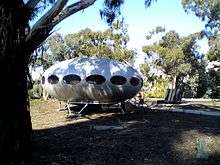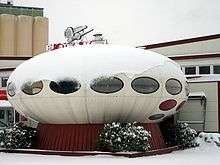Futuro
Futuro, or Futuro House, is a round, prefabricated house designed by Matti Suuronen, of which fewer than 100 were built during the late 1960s and early 1970s. The distinctive flying saucer-like shape and airplane hatch entrance has made the houses popular among collectors. The Futuro is composed of fiberglass-reinforced polyester plastic, polyester-polyurethane, and poly(methylmethacrylate), measuring 13 feet (4 metres) high and 26 feet (8 metres) in diameter.
History
The Futuro house was a product of post-war Finland, reflecting the period's faith in technology, the conquering of space, unprecedented economic growth, and an increase in leisure time. It was designed by Suuronen as a ski cabin that would be “quick to heat and easy to construct in rough terrain.” The end result was a universally transportable home that had the ability to be mass replicated and situated in almost any environment.

The material chosen for the project – fibreglass-reinforced polyester plastic – was familiar to Suuronen and was previously used in the design of a large plastic dome for the roof of a grain silo in Seinäjoki. To facilitate transport, the house consisted of 16 elements that were bolted together to form the floor and the roof. The project could be constructed on site, or dismantled and reassembled on site in two days, or even airlifted in one piece by helicopter to the site. The only necessity on site for its placement were four concrete piers, so the project could occupy nearly any topography. Due to the integrated polyurethane insulation and electric heating system, the house could be heated to a comfortable temperature in only thirty minutes, from -20 to 60 °F (-28,8 to 15,6 °C).[1]
An excerpt from a February 1970 copy of Architecture d’aujourd’hui describes “Futuro” as:
the first model in a series of holiday homes to be licensed in 50 countries, already mass-produced in the United States, Australia and Belgium. The segments of the elliptic envelope are assembled on the site using a metal footing. Through its shape and materials used, the house can be erected in very cold mountains or even by the sea. The area is 50 sq m, the volume 140 cubic m, divided by adaptable partitions.
By the mid-1970s, the house was taken off the market. From the beginning, it had been met with public hostility. The first Futuro that was erected near Lake Puulavesi in Finland elicited public protest because it looked too unnatural for the rustic environment. In the United States, Futuro houses were banned from many municipalities by zoning regulations. Banks were reluctant to finance them. Some were vandalized. Some customers who committed to buy them backed out and forfeited their non-refundable $1,000 deposits.[2] Some have been destroyed. In 1999, the city of Tampa ordered a Futuro demolished.[3] Shortly after the turn of the century, a Futuro house was purchased on Broadkill Beach, Delaware, and destroyed to make way for a double-wide modular home. Some have been vandalized in drive-by shootings.[2] The oil crisis of 1973 tripled gasoline prices and made manufacture of plastic extremely expensive. Fewer than 100 were made and it is estimated that today around 60 of the original Futuro homes survive,[4] owned mostly by private individuals. The prototype (serial number 000) is in the collection of Museum Boijmans Van Beuningen in Rotterdam, The Netherlands. The Futuro no. 001, the only other Futuro currently in a public collection, is in the possession of the WeeGee Exhibition Centre in Espoo, Finland.[5]
In 1998, Finnish film director Mika Taanila made a documentary film Futuro – A New Stance For Tomorrow about the Futuro house.
A UK artist, Craig Barnes, purchased and restored a Futuro house in 2013-14.[6] He had discovered the wreck whilst on holiday in South Africa and had it shipped back to the UK before commencing restoration. The Futuro house - the only one in the UK - is now on display to the public as part of an exhibition on the rooftop of an East London Gallery (until December 2014); the house was featured on the fourth series of the Channel 4 programme George Clarke's Amazing Spaces (Ep. 2[7]).
Material about the Futuro house

In 2010, Finnish conservator Anna-Maija Kuitunen made a damage assessment plan for the first Futuro ever made (serial number 001). This was done as her final thesis for the Metropolia University of Applied Sciences in Finland ("Futuro no. 001 – documentation and evaluation of preservation need"). The thesis is openly available via the Finnish Theses database and contains a large number of indoor detail photographs and drawings of the Futuro House.[8]
Microbial Degradation
One Futuro house was found to be biodegrading by Cyanobacteria and Archaea.[9][10]
See also
References
- ↑ Marko Home & Mika Taanila (eds.): Futuro: Tomorrow's House from Yesterday. Desura 2002. ISBN 952-5339-13-0
- 1 2 Eyewitness account of Hudson Management in Lewes, DE 19958
- ↑ "Futuro Home - Southwest corner of Semmes and Juneau St's., Tampa, Florida". Futurohouse.com. Retrieved 2014-01-02.
- ↑ Papworth, Jill (3 November 2015). "Welcome to the Futuro house". The Guardian. Retrieved 17 November 2015.
- ↑ "Exhibition Centre WeeGee > Futuro house". Weegee.fi. Retrieved 2014-01-02.
- ↑ "Futuro". Retrieved 31 October 2014.
- ↑ "George Clark's Amazing Spaces - Episode Guide". Channel 4. Retrieved 31 October 2014.
- ↑ Anna-Maija Kuitunen: Futuro no. 001 – documentation and evaluation of preservation need. 2010, Metropolia University of Applied Sciences, Finland. .
- ↑ Andrea Rinaldi (November 7, 2006). "Saving a fragile legacy. Biotechnology and microbiology are increasingly used to preserve and restore the worlds cultural heritage". EMBO Reports. 7 (11): 1075–1079. doi:10.1038/sj.embor.7400844. PMC 1679785
 . PMID 17077862.
. PMID 17077862. - ↑ Cappitelli F; Principi P; Sorlini C. (Aug 2006). "Biodeterioration of modern materials in contemporary collections: can biotechnology help?". Trends in biotechnology.
External links
| Wikimedia Commons has media related to Futuro. |
- Futuro
- FuturoMan's Website
- FuturoHouse.net
- The Futuro House - Information, Photos, Locations, Maps
- The Willetton UFO Conspiracy Theory Short film about the disappearance of an iconic Futuro "spaceship" that was in Willeton, Western Australia for many years.
- Futuro at the archINFORM database. - with worldwide map of Futuro locations
- Futuro pod that can be rented in Wisconsin
- blog post about a Casa Finlandia promotional video.
- Rebuilding The Futuro Prototype on Arttube (Boijmans)
- University of Canberra conservation students to restore Futuro building (university media release).
- follow a family living in 2 Futuro houses in Christchurch New Zealand
- Blog post with videos, Photos, Locations
